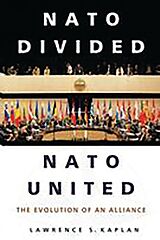NATO Divided, NATO United
Einband:
Kartonierter Einband
EAN:
9780275983772
Untertitel:
The Evolution of an Alliance
Genre:
Politikwissenschaft
Autor:
Lawrence S. Kaplan
Herausgeber:
Praeger
Anzahl Seiten:
178
Erscheinungsdatum:
05.09.2000
ISBN:
0275983773
Informationen zum Autor LAWRENCE S. KAPLAN is Emeritus University Professor of History and Director Emeritus of the Lyman L. Lemnitzer Center for NATO and European Union Studies at Kent State University. He is currently Adjunct Professor of History at Georgetown University. Klappentext This history of NATO concentrates on the differences within the alliance, particularly between the US and its European partners. NATO's war against terrorism began on September 11, 2001. Invoking Article 5 was a fitting response to the assault on the United States, but the spirit did not last long. Within a few weeks, old fissures within the alliance re-emerged, threatening once again to dissolve an entity that had survived over half a century. In the first two generations of NATO's existence, the Cold War with the Soviet Union had been the major purpose of its existence. But since the dissolution of the Warsaw Pact and of the Russian Empire itself, NATO has struggled to seek new raisons d'etre , and has succeeded to some degree in finding them in crisis management in Europe and in areas beyond the boundaries of the alliance.The absence of a traditional enemy to serve as a centripetal force, along with the recognition of the US as the lone superpower, has placed a focus on internal troubles of the alliance that had been obscured in the past by the presence of a common enemy. Too little attention has been paid to such West-West conflicts which arguably have been more frequent and more bitter, if not more dangerous, than the struggle with the Soviet Union. Differences among the allies began with the formation of the alliance itself. Some were resolved, others persisted. Many of them related to out of area issues in which the Soviet Union was not involved or only peripherally concerned. How the alliance managed the unequal relationship in the past may offer insights into the common ground the alliance partners can identify in the 21st century. Inhaltsverzeichnis NATO and Article 5: 2001 and 1949-1950 Impact of the Korean War: 1950-1958 The Gaullist Decade: 1958-1968 Détente and Its Limitations: 1968-1980 Ending the Cold War: 1980-1990 Seeking New Missions: 1990-1999 Into the New Millennium ...
Autorentext
LAWRENCE S. KAPLAN is Emeritus University Professor of History and Director Emeritus of the Lyman L. Lemnitzer Center for NATO and European Union Studies at Kent State University. He is currently Adjunct Professor of History at Georgetown University.
Klappentext
This history of NATO concentrates on the differences within the alliance, particularly between the US and its European partners. NATO's war against terrorism began on September 11, 2001. Invoking Article 5 was a fitting response to the assault on the United States, but the spirit did not last long. Within a few weeks, old fissures within the alliance re-emerged, threatening once again to dissolve an entity that had survived over half a century. In the first two generations of NATO's existence, the Cold War with the Soviet Union had been the major purpose of its existence. But since the dissolution of the Warsaw Pact and of the Russian Empire itself, NATO has struggled to seek new raisons d'etre, and has succeeded to some degree in finding them in crisis management in Europe and in areas beyond the boundaries of the alliance. The absence of a traditional enemy to serve as a centripetal force, along with the recognition of the US as the lone superpower, has placed a focus on internal troubles of the alliance that had been obscured in the past by the presence of a common enemy. Too little attention has been paid to such West-West conflicts which arguably have been more frequent and more bitter, if not more dangerous, than the struggle with the Soviet Union. Differences among the allies began with the formation of the alliance itself. Some were resolved, others persisted. Many of them related to out of area issues in which the Soviet Union was not involved or only peripherally concerned. How the alliance managed the unequal relationship in the past may offer insights into the common ground the alliance partners can identify in the 21st century.
Inhalt
NATO and Article 5: 2001 and 1949-1950
Impact of the Korean War: 1950-1958
The Gaullist Decade: 1958-1968
Détente and Its Limitations: 1968-1980
Ending the Cold War: 1980-1990
Seeking New Missions: 1990-1999
Into the New Millennium

Leider konnten wir für diesen Artikel keine Preise ermitteln ...
billigbuch.ch sucht jetzt für Sie die besten Angebote ...
Die aktuellen Verkaufspreise von 6 Onlineshops werden in Realtime abgefragt.
Sie können das gewünschte Produkt anschliessend direkt beim Anbieter Ihrer Wahl bestellen.
Loading...
Die aktuellen Verkaufspreise von 6 Onlineshops werden in Realtime abgefragt.
Sie können das gewünschte Produkt anschliessend direkt beim Anbieter Ihrer Wahl bestellen.
| # | Onlineshop | Preis CHF | Versand CHF | Total CHF | ||
|---|---|---|---|---|---|---|
| 1 | Seller | 0.00 | 0.00 | 0.00 |
